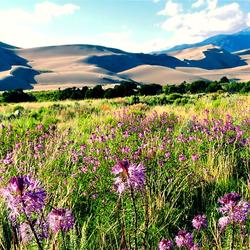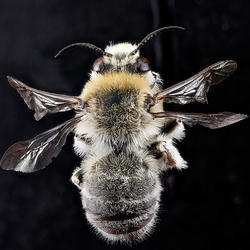Ecosystems
Ecosystems
What is cheatgrass and how is it harmful?
Cheatgrass (Bromus tectorum) originated in Europe or Eurasia and was introduced to the U.S. in the mid- to late-1800s as a contaminant in seed and straw. It germinates in the fall and early spring, and grows rapidly and in high numbers, making it highly competitive with native species. Cheatgrass is also disrupting the fire cycle in sage habitat and other Western ecosystems, leading to more...
How does climate change affect the challenge of invasive species?
Changing climate conditions have bearing on every aspect of biological invasions, in some cases worsening existing problems. Climate change is creating new pathways for invasive species to be introduced, such as shipping routes that open up as sea ice retreats. Warmer temperatures can allow existing invasive species to expand their range into habitat that is currently too cool. Similarly, impacts...
Does the loss of plant diversity affect the health of native bees?
Loss of plant diversity is the primary cause of native bee decline. About 30-50% of all native bees are highly specialized, so if the plant they rely on disappears, the bees go away. If the bees disappear, the plant is unable to reproduce and dies out. While some of the plants pollinated by native bees are important food crops, other plants pollinated by native bees are critical for healthy...
Do bees feed on both nectar and pollen?
Bees feed on and require both nectar and pollen. The nectar is for energy and the pollen provides protein and other nutrients. Most pollen is used by bees as larvae food, but bees also transfer it from plant-to-plant, providing the pollination services needed by plants and nature as a whole. Learn more: USGS Native Bee Inventory and Monitoring Program Bees of the Northeastern U.S.
How many species of native bees are in the United States?
There are over 20,000 known bee species in the world, and 4,000 of them are native to the United States. They range from the tiny (2 mm) and solitary Perdita minima , known as the world’s smallest bee, to kumquat-sized species of carpenter bees . Our bees come in as many sizes, shapes, and colors as the flowers they pollinate. There is still much that we don't know about native bees—many are...
Do native bees occur on every continent on the planet?
Native bees occur on every continent except Antarctica. Wherever there are insect-pollinated flowering plants—be it in forest, farms, cities, and wildlands—there are bees. And just because you don’t see obvious blooming plants, that does not mean that there are no bees around. Look down! Those tiny flowers that you see on some plants are also supporting billions of equally tiny bees. Learn more...
Are honey bees native to North America?
Honey bees are not native to North America. They were originally imported from Europe in the 17th century. Honey bees now help pollinate many U.S. crops like fruits and nuts. In a single year, one honey bee colony can gather about 40 pounds of pollen and 265 pounds of nectar. Honey bees increase our nation's crop values each year by more than 15 billion dollars. Critical honey bee populations in...
What is the role of native bees in the United States?
About 75% of North American plant species require an insect—mostly bees—to move their pollen from one plant to another to effect pollination. Unlike the well-known behavior of the non-native honeybees, there is much that we don’t know about native bees. Many native bees are smaller in size than a grain of rice. Of approximately 4,000 native bee species in the United States, 10% have not been named...
Why are pollinating bats, birds, bees, butterflies, and other animals important?
Do you enjoy a hot cup of coffee, a juicy peach, an-apple-a-day, almonds, rich and creamy dates, a handful of plump cashews, or vine-ripened tomatoes? Do you enjoy seeing the native flowers and plants that surround you? If so, you depend on pollinators. Wherever flowering plants flourish, pollinating bees, birds, butterflies, bats and other animals are hard at work, providing vital but often...
Can Burmese Pythons swim from the Everglades to the Florida Keys?
A number of Burmese pythons have been found on Key Largo, and a few in the Lower Keys. Because pythons regularly escape or are released from captivity, it can be difficult to determine whether a snake encountered in the Keys arrived there by swimming from the mainland or was a former captive pet on the island. Given the python’s ability to disperse via salt water, expansion into neighboring...
Are there invasive reptiles other than Burmese pythons in the United States that people should be concerned about?
Free-ranging, non-native reptiles representing dozens of species from around the world escape or are illegally released in the United States every year. Many of these species fail to establish reproductive populations, but some are successful. Florida is a major transportation hub and has a climate that is suitable for many invasive species across taxonomic groups. Due to the suitable climate, and...
What are the differences between endangered, threatened, imperiled, and at-risk species?
Under the Endangered Species Act (ESA), plant and animal species may be listed as either endangered or threatened. “Endangered” means a species is in danger of extinction throughout all or a significant portion of its range. “Threatened” means a species is likely to become endangered within the foreseeable future. States have their own ESA-type laws, so species can have different Threatened...













